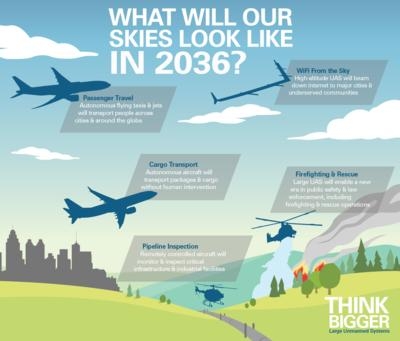Wed, Feb 28, 2018
Growth Seen As 'Explosive' Over The Next Two Decades
The Aerospace Industries Association, in partnership with Avascent, has released a study projecting explosive growth in the global market for large unmanned aerial systems (UAS) over the next two decades. The report, “Think Bigger: Large Unmanned Systems and the Next Major Shift in Aviation,” shows large UAS represent a cornerstone of future aviation, changing the nature of travel, technology and transport, and the economies surrounding those markets.

Specifically, spending on large UAS is expected to rise from the low hundreds of millions today to $30 billion annually by 2036, driven by manufacturing and services for long-haul cargo and passenger aircraft. The report also shows that spending will sustain up to 60,000 research, manufacturing and service jobs annually by the end of that timeframe.
“We have got to think bigger when it comes to the future of unmanned aviation,” said AIA President and CEO Eric Fanning. “The future unmanned systems market will change the way we travel and transport products. We could see entirely new economic centers where they don’t exist today. It’s an incredible opportunity, if government and industry start now on the regulations and technology to realize that potential.”
This new market requires U.S. regulators to adopt a posture that both ensures safety and fosters commercial innovation. Recommendations for maintaining U.S. leadership in this developing market include codifying near-term needs for detect-and-avoid operations, autonomous certification and spectrum allocation; international harmonization of regulations and performance-based consensus standards; and modifications of civilian UAS-related export and trade restrictions.
“The biggest barrier to growth is the regulatory framework,” Fanning said. “Global competitors are working to seize the market from the United States, the country that invented this technology. These are American jobs and American opportunities. But we must start now on certification standards, exports, and spectrum to ensure they stay American.”
(Source: AIA news release. Infographic provided)
More News
He Attempted To Restart The Engine Three Times. On The Third Restart Attempt, He Noticed That Flames Were Coming Out From The Right Wing Near The Fuel Cap Analysis: The pilot repor>[...]
Make Sure You NEVER Miss A New Story From Aero-News Network Do you ever feel like you never see posts from a certain person or page on Facebook or Instagram? Here’s how you c>[...]
From 2009 (YouTube Edition): Leading Air Show Performers Give Their Best Advice for Newcomers On December 6th through December 9th, the Paris Las Vegas Hotel hosted over 1,500 air >[...]
Aero Linx: NASA ASRS ASRS captures confidential reports, analyzes the resulting aviation safety data, and disseminates vital information to the aviation community. The ASRS is an i>[...]
“For our inaugural Pylon Racing Seminar in Roswell, we were thrilled to certify 60 pilots across our six closed-course pylon race classes. Not only did this year’s PRS >[...]
 NTSB Final Report: Rutan Long-EZ
NTSB Final Report: Rutan Long-EZ ANN FAQ: Turn On Post Notifications
ANN FAQ: Turn On Post Notifications Classic Aero-TV: ICAS Perspectives - Advice for New Air Show Performers
Classic Aero-TV: ICAS Perspectives - Advice for New Air Show Performers ANN's Daily Aero-Linx (06.28.25)
ANN's Daily Aero-Linx (06.28.25) Aero-News: Quote of the Day (06.28.25)
Aero-News: Quote of the Day (06.28.25)



